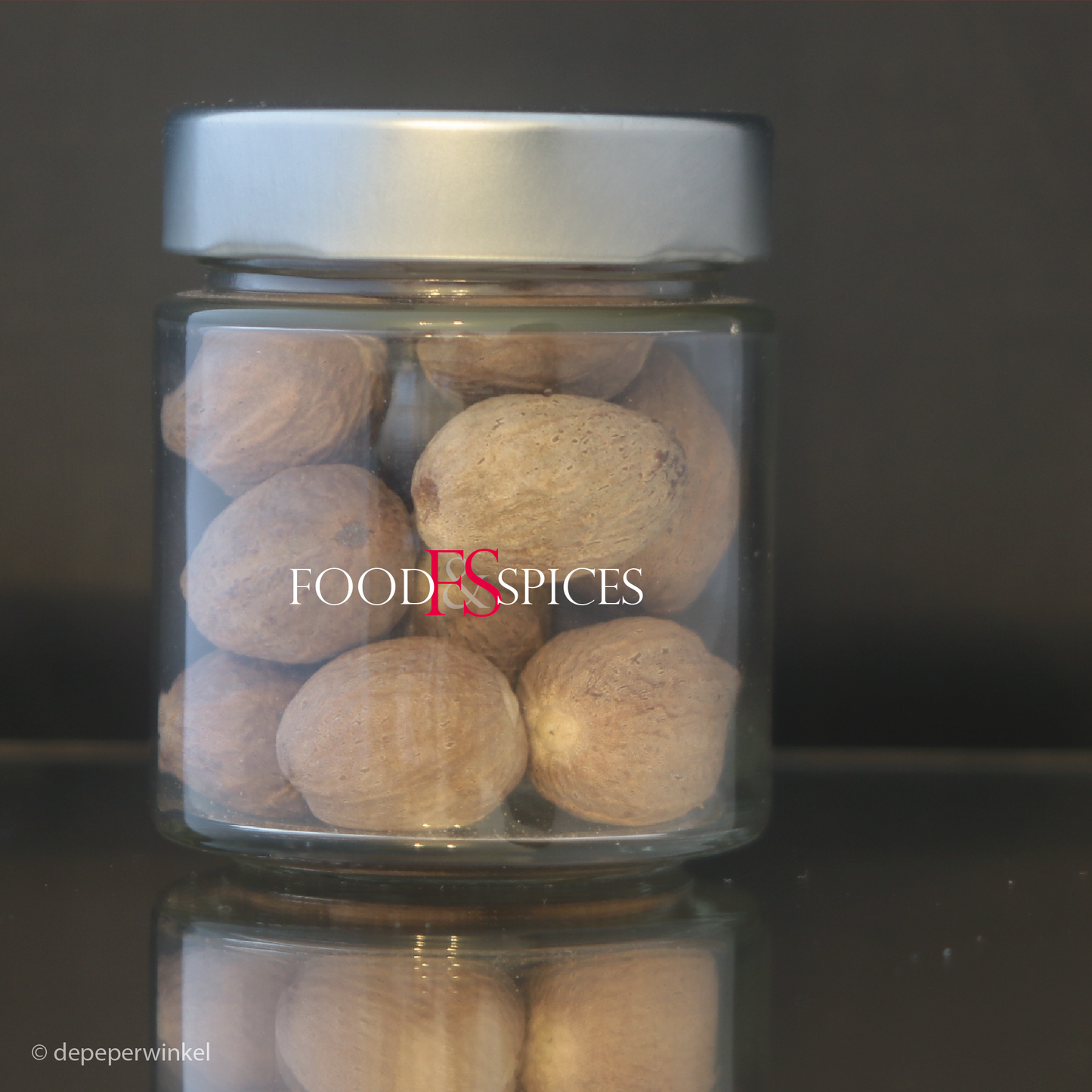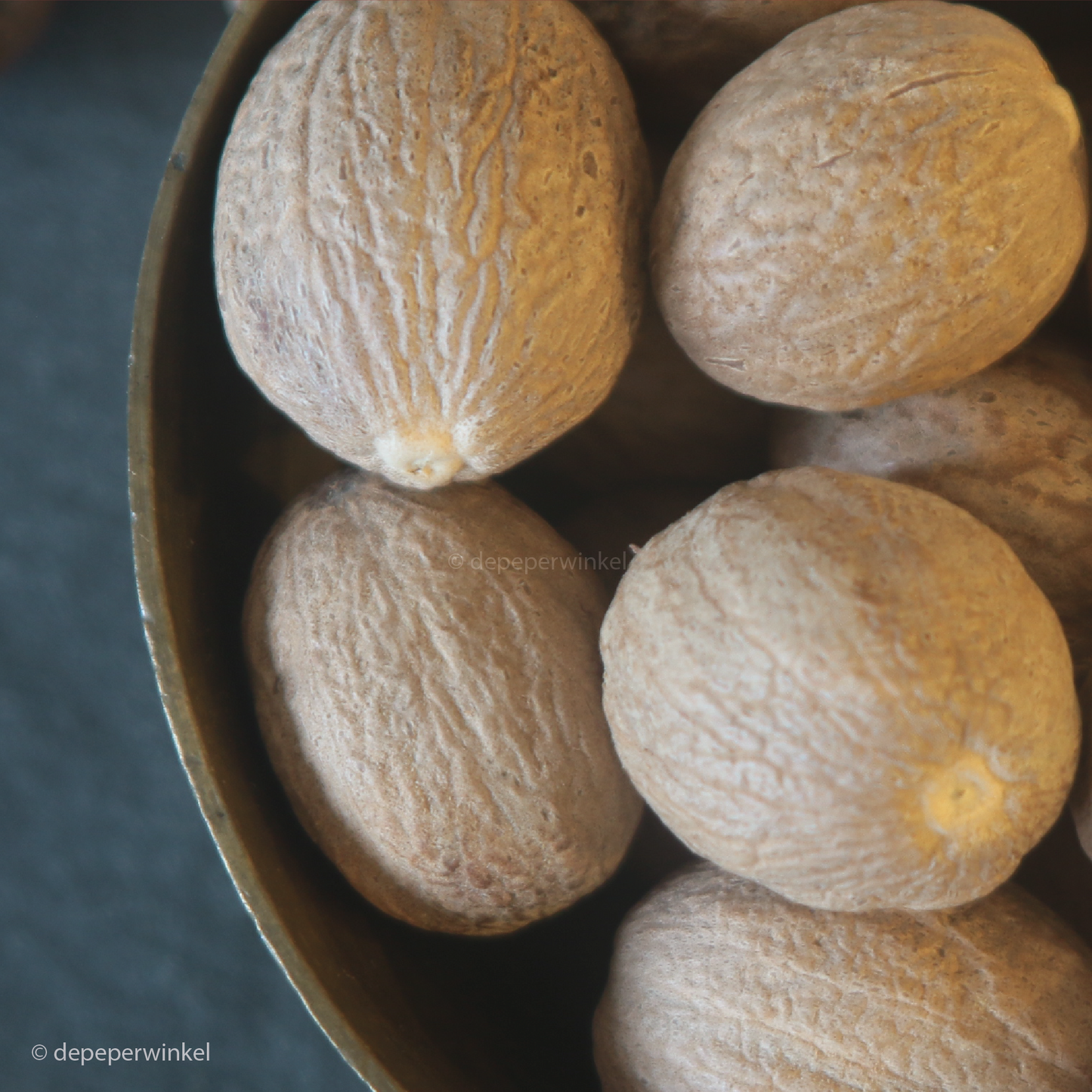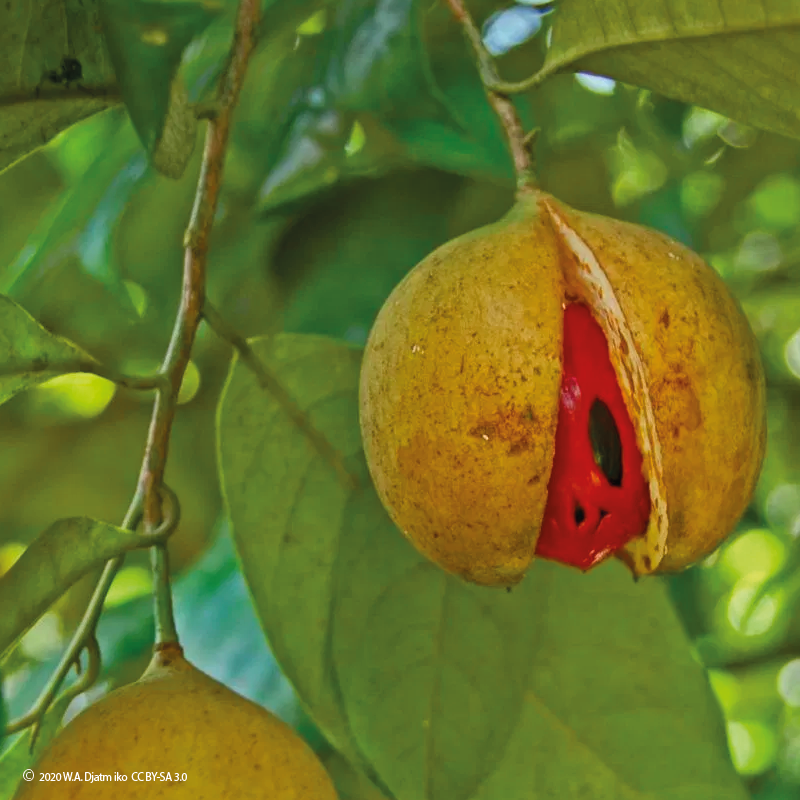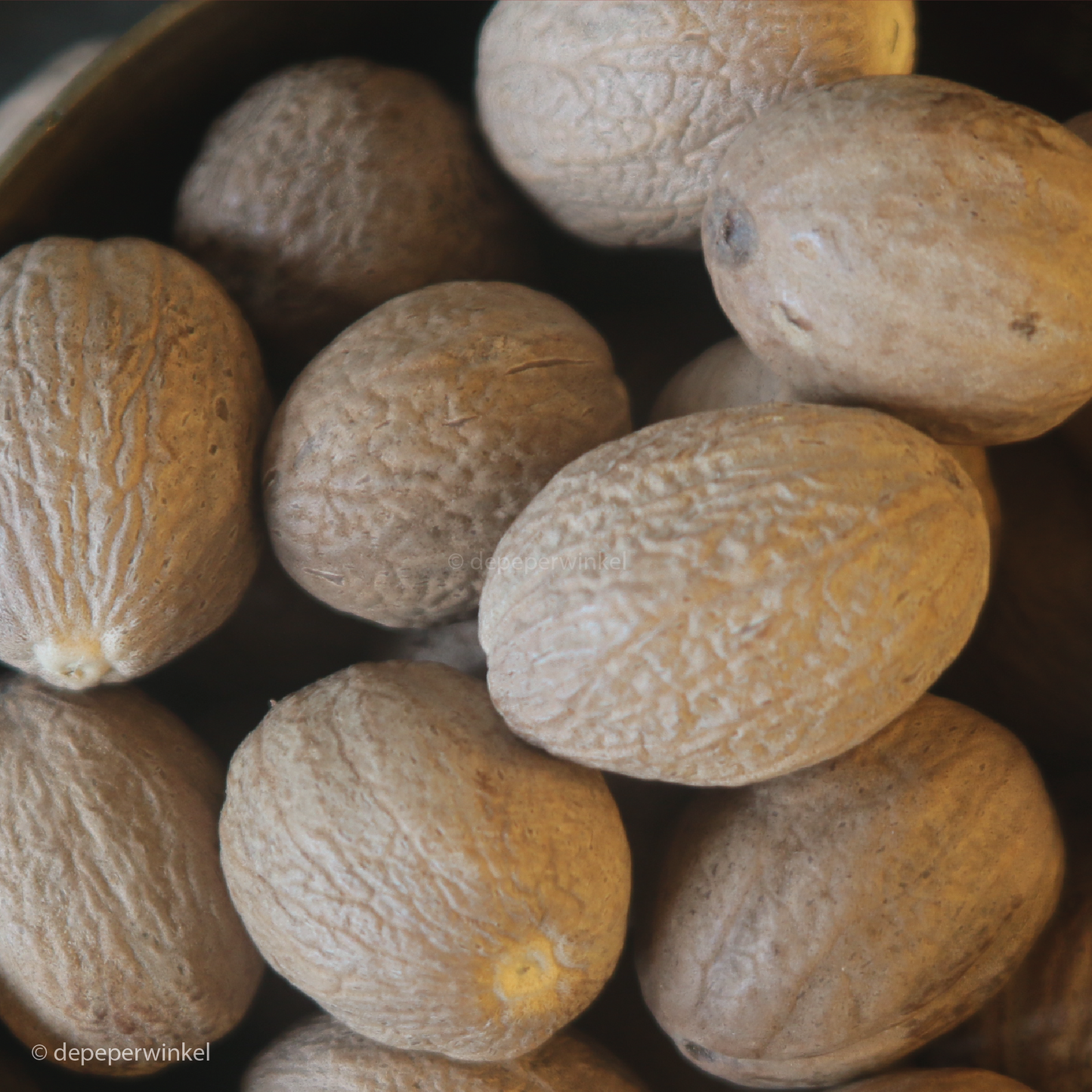depeperwinkel
Nutmeg
Nutmeg
Unable to load availability for pickup
The peeled seeds of the nutmeg tree are called nutmeg or nutmeg. Like the seed coat (mace), they are very aromatic. New in our range is this nutmeg from organic cultivation from India.
The nutmeg tree is an evergreen tree that originates from the Moluccas and is called pala there. But what exactly is nutmeg?
We know it as 'nut', but it is actually a kernel, the inner part of the seed, stripped of the hard shell. Elsewhere you can buy nutmeg with shell and all, in our country nutmeg is almost only available without shell. Not only this part, but also the seed coat and the pulp are edible. The fleece is considered a separate spice and is called mace.
The nutmeg, to use that word again, is oval -elliptoid - in shape and about an inch and a half long. The outside is ribbed, a pattern that you also see on the inside. Our nutmeg is a selection consisting of nuts weighing between 5 and 5.5 grams each.
The word nutmeg is a corruption of the Latin "nuces moschatae", which means 'musk-smelling nuts'. These are the main essential oils, those with an arterisk * are the main taste and smell determiners of this warm, fragrant spice:
- α- and β-pinene, woody pine odor, as in cumin, pine, juniper and hemp,
- elemicin *, hallucigonene, pungent smelling substance in nutmeg,
- limonene, the smell of lemon peel,
- methyl eugenol *, a floral aroma (mimosa),
- myristicine *, warm spicy, like balsamic vinegar, in cinnamon, nutmeg, black pepper, Assam pepper and parsley
- sabinene, responsible for the woody, camphoraceous flavor of black pepper, with citrus and pine cone notes, and
- safrole *, the smell of a candy store, present in cinnamon and nutmeg, among others.
Is this nutmeg organic?
In order to be able to supply this organically grown nutmeg under the organic label, we will have to be certified as a packer/producer of the spice. That's just how it is. We are not. Although we process and store organic products and products from regular cultivation strictly separately, we are not allowed to use the label organic.
Smell and taste
Nutmeg has a smell and aroma that is often referred to in other herbs and spices because it is so characteristic of nutmeg. The fragrance palette can be excellently combined with products that carry the same essential building blocks, including cinnamon, cloves, cardamom, ginger root, dill, sage, thyme and parsley, vegetables such as cabbage, carrot (cavalo nero, cauliflower), pumpkin and spinach, potatoes and onions , lamb, chicken, sharp-tasting cheeses such as Gruyère (think of cheese fondu) but also cream cheese or ricotta salata, and fruits such as pear and banana. And of course in béchamel sauce.
Usage
You still need tools to grind nutmeg, a grater, a plane or a mortar. Not every nutmeg grinder is equally useful, and many people therefore fall back on the old grater. We sell the Crushgrind nutmeg grinder from the Billund series, where you can grate any hard spice, not just nutmeg.
Nutmeg is severely underestimated in Western European cuisine. The cookbooks stammer a bit about green beans and cauliflower, but that's usually it. Nutmeg is of course indispensable in Indonesian cuisine, nor in Indian cuisine.
History in a nutshell
In the Middle Ages, the nutmeg trade was in the hands of Arabs, who supplied Europe with what was then called the nut muscate, a popular but expensive spice and medicine at the time. In the seventh century, the demand for this medicine was enormous. It was used against the plague, a pandemic that killed 75 million (!) people worldwide.
The Arabs kept the find location a secret, and saw the price skyrocket.
The Arab monopoly was broken when Vaso discovered the Gama of the archipelago where nutmeg grew. The Banda Islands in the Pacific Ocean. In the seventeenth century, these islands came into the hands of the Dutch East India Company, which had no means of safeguarding the monopoly. In 1621, Governor-General Jan Pieterszoon Coen proceeded with the violent 'extirpation' of the Banda Islands, under the guise that the population continued to sell nutmeg to the Portuguese and the British against the VOC's ban.
Coen ordered his troops to massacre the population. All nutmeg trees were also cut down, except those on the island of Banda Neira. There he reorganized production by dividing the largely depopulated island into plots and issuing them on long lease to so-called landowners. These were only allowed to supply the Company. The flowerbeds, as the plots were called, were maintained by gardeners, slaves from all parts of Asia.
The British succeeded in breaking the monopoly of the Dutch state at the beginning of the nineteenth century. The VOC had been nationalized shortly before, in 1796. The British presence was short-lived, because the Dutch quickly regained control of Banda. In that short period of time, the British secured the planting material and introduced cultivation in Grenada, Pendang, Ceylon, India and Zanzibar.
Zanzibar was not the first island off the East African coast where nutmeg was cultivatedwd. In the seventeenth century, the French botanist Jean Poivre succeeded in obtaining fertile seed under the VOC monopoly and planting it on the Île de France, as Mauritius was then called.
Africa has several indigenous alternatives to nutmeg, such as the West African ehuru or pèbè or gourd nutmeg (Monodora myristica). The taste resembles that of 'real' nutmeg, but the nut is more peppery, and is therefore also referred to as 'pepper'. Unfortunately, the home market for this special 'nutmeg' is shrinking due to the rise of 'real nutmeg'. In Madagascar, for example, several pseudo nutmegs grow naturally, such as the Rarabee, the Bashi-bashi and the Rhanha-horac.
The Banda Islands have always remained an important production area, but most nutmeg nowadays comes from India, especially from Tamil Nandu. However, most nutmeg that enters the Netherlands comes from Indonesia (86%). In our country, only 1% of all imported nutmeg comes from India.
Our nutmeg, for example. He comes from Ernakulamu, a district whose capital is Kochi, formerly Cochin. Ernakulam is located in Kerala, the region where our Malabar and Tellicherry peppers also come from. Our nutmeg farmers, united in a corporation, grow nutmeg organically.
Features:
- 100% dried kernels of the Myristica fragrans
- not powdered !
- origin: India, Ernakulam (Kochi/Cochin)
Assortment
- available in glass and stand-up pouch (no test tubes)
- glass jar contains approximately 45 grams
- stand-up bag with 45, 75, 250 or 500 grams (8, 14 and 45-50 nuts respectively)
- larger quantities on request
Gift packaging
- the jar is available in a tasteful gift packaging, consisting of a cube box filled with black tissue paper
- for an overview of our gift packaging, please refer to the gift packaging section
Health aspects
Raw nutmeg, including freshly ground nutmeg, contains a lot of myristicin and elemicin, hallicinogenic substances. When you use nutmeg as a spice, you won't notice it, but in higher doses you will. This is the basis for the popularity of the Indonesian nutmeg cigarette, the kretek, which also contains cloves. When used normally, nutmeg is harmless. Overdose means eating one or more whole nuts per day.
General advice
- Grind nutmeg just before using it in a preparation, once ground it loses its aromas quite quickly
Save:
- Store your nutmeg in closed packaging, for example an opened nut in the storage compartment of the nutmeg mill
- preferably store in a dark, dry and cool place
- best before July 2026 (07/26)
- this expiration date is an indication
Share







